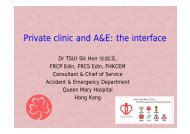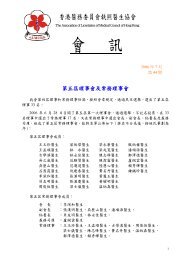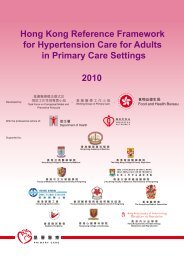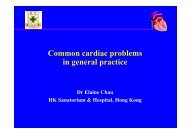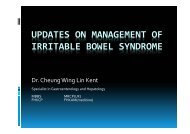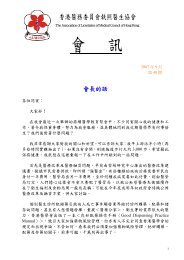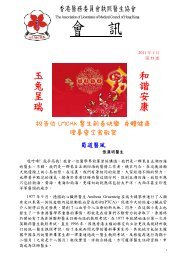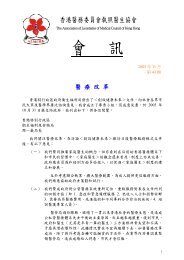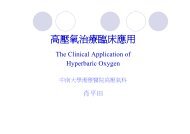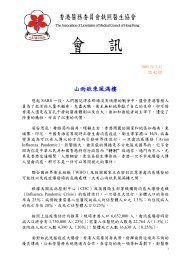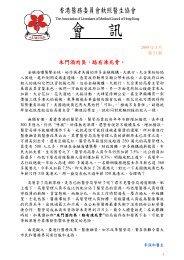2013年3月24日 - 香港醫務委員會執照醫生協會
2013年3月24日 - 香港醫務委員會執照醫生協會
2013年3月24日 - 香港醫務委員會執照醫生協會
You also want an ePaper? Increase the reach of your titles
YUMPU automatically turns print PDFs into web optimized ePapers that Google loves.
持 續 醫 學 教 育 (CME) 學 術 講 座香 港 醫 務 委 員 會 執 照 醫 生 協 會24 March 2013Common Vascular Disease常 見 血 管 外 科 疾 病Dr Renny Yien 顏 令 朱 醫 生Vascular Surgeon 血 管 外 科 醫 生Specialist in General Surgery 外 科 專 科 醫 生MBBS(HK), FRCS(Edin), FCSHK, FRCSEd (Gen), FHKAM(Surgery)Parkway Health
Vascular Disease 血 管 疾 病•Varicose Veins 靜 脈 曲 張•Aortic Aneurysm 主 動 脈 瘤•Peripheral vascular disease 周 邊 動 脈 阻 塞 疾 病•Carotid stenosis 頸 動 脈 狹 窄 症Dr Renny YienParkway Health
What is VaricoseVein? 靜 脈 曲 張A varicose vein is aSuperficial 表 面, protruding dilatedvein NOT causedby:•Previous deep veinthrombosis 下 肢 深 静 脉 血 栓•AV malformations
Leg Vein Anatomy 腿 部 靜 脈 解 剖• Network of veins to carryblood to the heart.• The venous system iscomprised of• Deep Veins 深 靜 脈• Superficial Veins 淺 靜 脈• 90% of the blood isreturned to the heart bythe deep system alone
Perforators交 通 静 脈Perforating veins connect thedeep system with the superficialsystemThey pass through the deep fasciaat mid-thigh, knee and ankle
Muscle Pump肌 肉 泵Venous blood flows fromthe capillaries to the heartLow flow, low pressuresystem•Contractions propel bloodtoward heart•Relaxation draws bloodfrom- superficial veins- lower deep veins
Thoracoabdominal Pump胸 腹 泵• Inspiration decreasesintrathoracic pressurepromoting venousreturn• Expiration reverses theprocess
Valves 瓣 膜• Maintain unidirectional flow• Extremity to heart• Superficial to deep• GSV and SSV with terminal andpreterminal valves• Terminal (sentinel or first) valve withfirm thickened white cusps differentfrom the rest of the valves
Etiology 病 因• Pregnancy 懷 孕• Pelvic obstruction 盆 腔 阻 塞• Chronic straining• Prolonged standing 長 時 間 站 立• Prolonged sitting especially withlegs habitually crossed• Obesity 肥 胖
Why do Varicose Veins Occur?為 什 麼 ?• Heredity Risk? 遺 傳 風 險• Both parents = 80%• 50/50 chance if one parent• 20% chance of neither parent• More common in females ⼥ 性• Pregnancy (labial varicosities/ Plevicobstruction?)• Taking hormones
Symptoms of Varicose Veins症 狀• Pain 疼 痛 : sharp, aching, throbbing,tingling• Cramps 抽 筋 , heaviness, tiredness of legs,“Restless” legs at night• 皮 膚 病 Itching, dermatitis,hyperpigmentation, ulceration of the skin,bleeding, blood clots• 外 觀 Poor appearance of the legs
Superficial Venous Insufficiency淺 靜 脈 功 能 不 全• Abnormal veins• telangiectasia (spider)毛 細 血 管 擴 張 症• Reticular NonsaphenousVV• Saphenous VV• Abnormal skin
Superficial Venous Insufficiency• Abnormal veins• telangiectasia (spider)• Reticular 網 殼 結 構• Non-saphenous VV• Saphenous VV• Abnormal skin
Superficial Venous Insufficiency• Abnormal veins• telangiectasia (spider)• Reticular• Non-saphenous VV 非大 隱 靜 脈• Saphenous VV• Abnormal skin
Superficial Venous Insufficiency• Abnormal veins• telangiectasia (spider)• Reticular• Non-saphenous VV• Saphenous VV 隱 靜 脈• Abnormal skin
Superficial Venous Insufficiency• Abnormal veins• Abnormal skin• Eczema 濕 疹• Edema• corona phlebectatica• Lipodermatosclerosis• ulceration
Superficial Venous Insufficiency• Abnormal veins• Abnormal skin• Eczema• Edema 浮 腫• corona phlebectatica• Lipodermatosclerosis• ulceration
Superficial Venous Insufficiency• Abnormal veins• Abnormal skin• Eczema• Edema• corona phlebectatica環 狀 靜 脈 擴 張• Lipodermatosclerosis• ulceration
Superficial Venous Insufficiency• Abnormal veins• Abnormal skin• Eczema• Edema• corona phlebectatica• Lipodermatosclerosis脂 性 硬 皮 病• ulceration
Superficial Venous Insufficiency• Abnormal veins• Abnormal skin• Eczema• Edema• corona phlebectatica• Lipodermatosclerosis• Ulceration 潰 瘍
Classification of CVD (CEAP)慢 性 靜 脈 功 能 不 足 分 類• C - clinical sign0: No visible venous disease 無 肉 眼 可 見 的 靜 脈 疾 病1: Telangiectasias or reticular 毛 細 血 管 擴 張 或 網 狀 靜 脈2: Varicose veins 靜 脈 曲 張3: Edema 水 腫4: Skin changes 皮 膚 變 化5: Healed ulceration 癒 合 潰 瘍6: Active ulceration 潰 瘍
Evaluation of Vein Patients評 估•History and physical examination• Coagulation disorders• Thrombophlebitis or deep veinthrombosis• Diabetes or other arterial disorder• Results of previous treatment•Blood flow tests
Blood flow tests 血 流 量 測 試• Most tests are non-invasive• Hand-held doppler多 普 勒• Duplex ultrasound多 普 勒 超 聲 檢 查• Others• Patient selection• Establish anatomy• Establish function (reflux)
Treatment Goals 治 療 目 標Cosmetically Acceptable Control ofVenous Reflux 美 觀 上 可 接 受•Control of the highest source of backwardflow (reflux) and reduction of venoushypertension• Great and lesser saphenous veins• Perforator veins•Branch varicosities and spider veins
What Treatment Methodsare Available? 治 療 方 法 ?• Surgery Stripping 外 科 手 術• GSV or SSV• Microincison phlebectomy• Endovenous ablation therapy 腔 內 消 融 治 療• RFA 射 頻 or Laser 激 光• Ultrasound guided injection (glue, or sclerosant)• Compression garments only 壓 力 縮 襪• No treatment
Surgery 外 科 手 術• SFJ Flush ligation• Stripping GSV, microphlebectomy
Results of Surgery 結 果Fischer R, et al. The Unresolved Problem of RecurrentSaphenofemoral Reflux. J Am Coll Surg 2002; 195:80-94.
Surgical Complications 並 發 症• Wound Infection 傷 口 感 染• Hematoma/severebruising 血 腫 / 嚴 重 的 瘀 傷• Scarring 疤 痕• DVT 下 肢 深 靜 脈 血 栓• Recurrence 復 發
Endovenous Ablation Therapy腔 內 消 融 治 療• Laser (EVLT) 激 光• Laser precaution• Higher temperature• Slightly more burn, numbness,phlebitis, induration• Radiofrequency ablation 射 頻• Heats up to 220 o C• Vein shrink around the probe, thevein closes• Less bruising, pain• Result same as EVLT
RFA (Closure TM Procedure) 射 頻A Minimally Invasive Alternative to Vein Stripping Surgery
RFA (Closure TM Procedure)
RFA (Closure TM Procedure)• Local, regional, or general anesthesia• Access vein• Insert catheter into the vein and advanceclosure catheter tip to SFJ using US• Compress saphenous vein and displace bloodaway from catheter electrodes
Pre/Post 術 前 後
Pre/Post 術 前 後
Treatment of primary varicose veinsby endovenous obliteration with theVNUS closure system: results of aprospective multicentre studyRFA saphenous vein obliteration improvessymptoms of varicose veins. Reflux-freerates in treated veins remain constant over3 yr f/u.Eur J Vasc Endovasc Surg. 2005 Apr;29(4):433-9.
Treatment of Small Vein disease小 靜 脈 疾 病• Female• Heredity• Pregnancy• Steroid or estrogens• Red or blue in color• Close to surface and notraised
Common Symptoms常 見 症 狀• Localized pain - similar to a bruise• Burning sensation• Aching• Often no symptoms. Treatment cosmetic only• Symptoms worsened by warm weather and/orby menstrual cycle
Foam Sclerotherapy –Results 泡 沫 硬 化 劑• 1-3% Sodium tetradecyl sulphate (STD)• Excellent for small veins: reticular, telangiectasias• High recanalization rates for larger veins, GSV: >50% recurrent• Complications• Ulceration • Pain• Pigmentation • Phlebitis• Secondarytelangiectasia
Foam Sclerotherapy -Procedure• Several injections per visit with small gaugeneedles• Injected areas become reddened and “beesting” wheals occur for several hours• Moderately uncomfortable• Several treatments• Compressive bandaging after treatment• Appearance often “worse before better”
Contraindications• Pregnancy• Inability to walk• Allergy to sclerosant
Post Sclerotherapy Instructions• Avoid vigorous impact activities for 3 days• Compliance with use of compression garment• Avoid prolonged sun exposure for several weeks• Follow up visits essential for best results
Patient Selection• Better results with injection of spider veins andsmall varicose veins• Some patients require combination of surgery forlarge veins followed by sclerotherapy for smallerveins• Large varicose veins when injected may re-opensoon after treatment• Higher risk of complications with sclerotherapy oflarge varicose veins
Long Term Results• 80-90% clearing of treated area• Improvement of symptoms• Cosmetic improvement• Variable rate of recurrence
Venaseal TM Sapheon Closure System• USG guided endovenous medical adhesive (Glue)to close the abnormal great saphenous veinwithout surgery• VenaSeal does not requiretumescent anesthesia or preproceduresedatives• Require minimal posttreatmentpain medication orno compression stockings.
Risk with Glue 膠 水• Allergic reaction to cyanoacrylate• Phlebitis 靜 脈 炎• DVT, pulmonary embolism• Hematoma• Infection.
eSCOPE EuropeanObservational Trial• 69 Patients enrolled in a single arm trial• 7 Centers, UK, Germany, Netherlands, Denmark• 9 Investigators (MD)• Follow-up: 24-48 hr, 1, 3, 6 and 12 months• Enrollment ended July 31, 2012• Closure Rate 95% at 3 months
AbdominalAortic Aneurysm腹 主 動 脈 瘤
What is an Abdominal AorticAneurysm (or AAA)? 腹 主 動 脈 瘤• An Abdominal Aortic Aneurysm (AAA) is a permanentlocalized dilatation of the abdominal aorta.• The disorder is defined as the aortic diameter is 30 mm or more.• If a AAA goesundetected anduntreated, it can rupture破 裂 and lead to massiveinternal bleeding anddeath 內 部 出 血 而 死 亡
Why are AAAs a serioushealthcare issue? 嚴 重 的 醫 療 問 題• AAA is the 10th leadingcause of death in menin HK.• A silent killer 沉 默 的 殺 手because there areoften no symptomsthat an aneurysm isdeveloping in theabdominal aorta.
Why is early diagnosis ofAAA so important? 早 期 診 斷• The operative mortality ⼿ 術 死 亡 率 of treating aruptured aneurysm is 30-70%.• For elective 非 緊 急 擇 期 手 術 AAA cases, theoperative mortality rate is drastically reduced,approximately only 2-5% of cases result in death.• AAA ruptures can be avoided by identifying thepopulation at risk and conducting simple andinexpensive ultrasound examinations.
Epidemiology(1999-2000 HK)• Annual incidence of AAA in HK: 13.7 per 100,000population, 105 per 100,000 for those aged 65and above• Mean age: 74, 84% > 65• Operative repair rate:- 8% for intact, 54% forrupture, 45% overall• Territory-wide operative mortality rates:- 10% (4-24%) for intact, 70% (38-100%) for rupture• Low repair rates for intact AAA, high proportionfor ruptured-> AAA under treatment in HKSWK CHENG ET AL. EPIDEMIOLOGY AND OUTCOME OF AORTIC ANEURYSM INHONG KONG. WORLD JOURNAL OF SURGERY VOL 27, NO 2/ FEB 2003
How to prevent? 預 防• No AAA screening program 篩 選 程 序 is in place inHK today• A simple ultrasound examination 超 聲 檢 查 easilydetects aneurysms
Types of AAA• Morphological Classification• Fusiform aneurysms 梭 形 動 脈 瘤• Saccular aneurysms 囊 狀 動 脈 瘤• Dissecting aneurysms 夾 層 動 脈 瘤• Pseudo-aneurysms 假 性 動 脈 瘤• Segments involved• Thoracic• Thoraco-abdominal• Abdominal• Main branches of the aorta• Iliac arteries
Ruptured AAAs are fatal in 82% of cases• Mortality is high due to rapidcirculatory collapse.• Up to 50% of patients withuntreated aneurysms > 5.5cm will die of rupture within5 years.• Less than 50% of emergencycases arrive at the hospitallive; out of those, only 50%survive conventional AAArepair.
How can you diagnose a AAA?• AAA is an asymptomatic disease.• Physical examination:• Palpation, you may notice orfeel a throbbing, tender massthe patient’s abdomen.• However, you may miss up to 80%of AAA if the diagnosis is limitedto physical examination.• Most of the time, AAAs arediagnosed too late, i.e. whenthey rupture.
How can you diagnose a AAA?• Ultrasound scan has proven to be areliable and cost-effective way todiagnose a AAA.• It is an extremelysensitive test for all AAAsizes.• It is painless andnon-invasive.• It is cost-effective.
What if a AAA>5cm isdiagnosed?• The patient should be referred to a vascularsurgeonOpen Surgery開 放 性 手 術Endovascular Stent Grafting血 管 內 支 架 置 入 術
EVAR Animation
Open surgical repair: advantages開 放 性 手 術 : 優 點• Aneurysm opened, graft sewn in,aorta wrapped and closedaround graft• Established procedure (with morethan 40 years of clinicalexperience)• Excludes aneurysm and preventssac growth• Proven, long-term results實 踐 證 明 , 長 期 的 結 果
Open surgical repair: drawbacks開 放 性 手 術 : 缺 點• Significant incision in theabdomen 顯 著 手 術 切 口• 30–90 minute cross-clamp• Up to 4-hour procedure• Contraindicated in some patients• 1–2 days intensive care7–14 days hospitalization4–6 weeks recovery time
Endovascular stent : advantages血 管 內 支 架 置 入 術 : 優 點• Benefits• Minimally invasive 微 創• Reduced risk of death死 亡 的 風 險 降 低• Faster recovery 術 後 恢 復 快• Improved functionaloutcomes 功 能 性 結 果
Endovascular stent grafting:drawbacks血 管 內 支 架 置 入 術 : 缺 點• Complications and re-interventions:• Endoleaks• Stent graft migration• Modular dislocation• Most complications are benign and treatable byendovascular techniques.• New stent graft generations are associated withfewer complications.
Open Vs EVAR
Take Home Messages• Who are the patients at risk ofAAA?• Predominantly males• 60 years old or older• Smoking history• Hypertension• Family history of AAA• What should I do with apatient at risk?• An ultrasound examinationmay be performed tocheck the presence of aAAA. Palpation is noteffective with all patients.• What is the main riskassociated AAA?• The risk of rupture• Only 18% of patients with aruptured AAA survive.• Operative mortality inelective cases is less than5% with open surgery andless than 2% withendovascular repair.• It is important to diagnoseAAA as early as possible.
PeripheralVascularDisease週 邊 動 脈 阻 塞 性 疾 病
Peripheral Vascular Disease週 邊 動 脈 阻 塞 性 疾 病• Atherosclerosis 粥 樣 動 脈 硬 化• Hardening of the arteriesaffects blood flow to the legs• Depending on a patient'sseverity of PVD, it cancause pain or evengangrene of a limb
Epidemiology 流 行 病 學• Demographic and biochemical risk factors• smoking 吸 煙 (59%)• Hypertension 高 血 壓 (55%)• diabetes mellitus 糖 尿 病 (42%)• Hypercholesterolemia 高 膽 固 醇 (55%)• elevated low density lipoprotein (LDL) 60%)• triglycerides (31%)• Hyperfibrinogenemia 纖 維 蛋 白 原 血 症 (62%)• Hyperglycemia 高 血 糖 (49%)Cheng SW. Epidemiology of atherosclerotic peripheral arterial occlusive disease inHong Kong. World J Surg. 1999 Feb;23(2):202-6.
Classification of PVD:Fontaine’s Stages andRutherford’s CategoriesFontaineRutherfordStage Clinical Grade Category ClinicalI Asymptomatic 無 症 狀 0 0 AsymptomaticIIaIIbMild claudication間 歇 性 跛 行Moderate-severeclaudicationI 1 Mild claudicationI 2 Moderate claudicationI 3 Severe claudicationIII Ischaemic rest pain II 4 Ischaemic rest painIVUlceration 潰 瘍 organgrene 壞 疽III 5 Minor tissue lossIII 6 Major tissue loss
Clinical Presentation of PVDPatientsAdapted from Hirsch AT. Fam Pract Recertification. 2000;15(suppl):6-12.
How do they present?• Can be asymptomatic 無 症 狀 forlong time• Primary symptom (early stage):Intermittent claudication (IC)間 歇 性 跛 行• Secondary symptom (late stage):Critical Limb Ischemia (CLI)重 症 肢 體 缺 血• necrosis, gangrene, ulcerationApelquist J et al.: Long-term costs for foot ulcers in diabetic patients in amultidisciplinary setting. Foot and Ankle International 1995;16:388
Clinical evaluation 臨 床 評 價•Clinical examinations follows theusual rules:• Inspections 檢 查• Palpation 觸 診• Auscultation 聽 診Vascular Medicine - Therapy and Practice - ABW WissenschaftsverlagGmbH 2010; 104; 140
Inspection 檢 查• Particular in advanced chronic stages,trophic disturbances are notices whichmay include:• reduced hair growth on the legs• slow nail growth• Livedo• thinning of the skinVascular Medicine - Therapy and Practice - ABW Wissenschaftsverlag GmbH 2010; 140
Palpation 觸 診• Method of palpating thefemoral pulse in the skincrease of groinJonathan D Beard, BMJ 2000;320:854-857• Method of palpatingdorsalis pedis and posteriortibial
Ankle-Brachial Index (ABI)踝 臂 指 數• ABI is the ratio of the ankle to brachialsystolic blood pressure• Measured using a blood pressure cuffand handheld Doppler device(continuous wave doppler probe)• ABI measurement is calculated bydividing the highest pressure at theankle by the higher systolic pressure ofthe right and left brachial arterieswww.tasc-2-pad.org - Management of IC;Techniques for Peripheral Interventions, Urban & Vogel GmbH, 2007; 11
Ankle-Brachial Index (ABI)踝 臂 指 數
Ankle-Brachial Index (ABI)踝 臂 指 數ABI value Diagnosis What It Means1.00 to 1.29 Normal Normal range and patient is not likely to have PVD0.91-0.99 BorderlineLower than normal, but not enough to diagnose PVDABI might be measured again after exercise0.41 to 0.90 Mild-to-moderatePVDPatient has PVDControl risk factorsAntiplatlet agent for cardiovascular risk reduction0.40 or less Severe PADMay need immediate treatment to relieve symptoms andprevent serious complicationPatients with very high ABI (>1.30) may have calcified arteries and require further assessmentHirsch, ACC/AHA Practice Guidelines, 2006 - J Am Coll Cardiol;www.tasc-2-pad.org - Management of IC
Duplex ultrasonography多 普 勒 超 聲• B-mode Ultrasound +Doppler waveform• Normal triphasic• Cardiac systole results in theinitial forward flow• A brief period of flow reversalin early diastole• Subsequent forward flow inlate diastoleManual of Carotid and Peripheral Vascular Interventions,T. Limpijankit, Beyond Enterprise Co., Ltd, 2008, 17
Magnetic Resonanceangiography (MR)磁 共 振 血 管 造 影•Allows three-dimensional (3-D) imaging ofall vessels at any level•Problem:• Overestimation of stenosis• Calcified structures are not identified• Patients with metallic implants cannot beexamined (e.g. defibrillators, intracerebral shunts)Vascular Medicine - Therapy and Practice - ABW Wissenschaftsverlag GmbH 2010; 141-142
Magnetic Resonanceangiography (MR)Supra-aortic, carotids andcerebral vesselsAV shunt and multiple stenoses ofthe brachial veinVisualization of lower leg vessels, collaterals in apatient with stenoses and occlusions
Computed tomographyangiography (CTA)電 腦 斷 層 掃 描 血 管 造 影•Minimally invasive•Requires an intravenous (IV) and contrastinjection•Use of radiation•Shows remarkable detail of the vessels•Costly
Computed tomographyangiography (CTA)•Disadvantage:• High level of radiation exposure• Need large amount of contras agent• Difficulties to distinguish betweencalcified, occluded lumen and aperfused lumen in lower leg areasVascular Medicine - Therapy and Practice - ABW Wissenschaftsverlag GmbH 2010; 142
Computed tomographyangiography (CTA)
Treatment options• In 1980’s 4 Words•Keep Walking保 持 行 走•Stop Smoking停 止 吸 煙
Treatment optionsExercise TherapyLifestyle ModificationsMedicationDietSmoking CessationDiabetes managementBlood pressure controlFoot CareRevascularization運 動 療 法生 活 方 式 的 改 變藥 物 治 療飲 食戒 菸糖 尿 病 管 理血 壓 管 理足 部 護 理血 運 重 建Vary and depend onthe overall health ofthe patient and theseverity of thediagnosis
Treatment Mnemonic治 療 助 記 符• Anti-platelet (aspirin) 抗 ⾎⼩ 板 ( 阿 司 匹 林 )• Blood pressure control ⾎ 壓 控 制• Cessation of smoking 停 ⽌ 吸 煙• Diet, to avoid overweight and have a low fat diet飲 食 , 避 免 超 重 和 低 脂 肪 的 飲 食• Exercise therapy 運 動 療 法• Foot care ⾜ 部 護 理• Glucose control for diabetes ⾎ 糖 控 制• HMG CoA reductase inhibitor i.e. statin 他 汀 類 藥
Walking Training 步 ⾏ 訓 練• Exercise therapy [ Grade A evidence]• Treadmill 跑 步 機• Sufficient intensity to bring on claudication• Followed by rest• Over 30-60mins• 3x/ week for 3 months• Improving walking distance greatermobility, improvement in Quality of life⽣ 活 質 量
Medication 藥 物 治 療• Cilostazol• Phosphodiesterase III inhibitor• Vasodilator, metabolic andantiplatelet activity• 3-6 month course of cilostazolshould be the first line treatmentfor the relief of claudicationsymptoms• Naftidrofuryl• 5-hydroxytrptamine type 2antagonist• Improve muscle metabolism• Reduce erythrocyte andplatelet aggregation
Revascularization- Indication⾎ 運 重 建 術• Critical limb ischaemia 嚴 重 肢 體 缺 血• Life style limiting Intermittent Claudication有 ⽣ 活 ⽅ 式 受 限 制 的 間 歇 性 跛 ⾏
Revascularization options• Endovascular Treatment血 管 內 治 療•Balloon Angioplasty 球 囊 血 管 成形 術•Cutting Balloon•Stents - BMS, DES, Coveredstents ⽀ 架•Atherectomy•Cryoplasty• Surgical bypass 搭 橋 ⼿ 術• Prosthetic graft• Autogenous vein graft
How to Choose?• Endovascular Method• Less invasivecompared to opensurgery• The patient is normallytreated while underlocal anaesthesia• Hospital stay is reducedcompared to opensurgery• Surgical Bypass• Better patency rates• Less reinterventions dueto restenosis• Useful in multiple-levelstenoses• Better cost-benefit ratioparticularly in severeadvanced PVDEndovascular First Approach
Balloon angioplasty forAorto-iliac Disease主 髂 動 脈 疾 病 - 球 囊 血 管 成 形 術
Aortobifemoral Bypass
Iliac-femoral / Iliac-poplitealBypass
PTA + Cross femoral Bypass
AxillobifemoralBypass• Reduces operative mortality• Inferior primary patencyrate• Not for the treatment of IC
Take home messages• Early Index of suspicion 懷 疑• ABI for diagnosis 踝 臂 指 數 診 斷• Aspirin 阿 司 匹 林• Find a vascular surgeon 血 管 外科 醫 生
CarotidStenosis頸 動 脈 狹 窄
What Is Carotid ArteryDisease?• Narrowing of the carotid arteries, caused byatherosclerosis on the inside of the vessels, decreasingblood flow to the brain and increasing the risk of astroke• Brain cells deprived of the oxygen and glucose formore than 3 to 6 hours, the damage is usuallypermanent• A stroke 中 ⾵ can occur if:• The artery becomes extremely narrowed.• A piece of plaque breaks off and travels to the smallerarteries of the brain.• A blood clot forms and blocks a narrowed artery.
What Are the Risk Factors?⾵ 險 因 素• Family history of atherosclerosis (either coronary artery disease orcarotid artery disease) 家 史• Age (men under age 75 have a greater risk of developing thedisease than women, but the risk is higher in women after age 75)年 ⽼• Smoking 抽 煙• Hypertension ⾼⾎ 壓• Diabetes 糖 尿 病• Obesity 肥 胖• Lack of exercise Typically, the carotid arteries become diseased a few years later thanthe coronary arteries.
What Are the Symptoms ofCarotid Artery Disease?• Asymptomatic 無 症 狀• Warning signs of impendingstroke• Transient IschaemicAttack (TIA) 短 暫 性 腦 缺 血• a blood clot brieflyblocks an artery thatsupplies blood to thebrain• temporary and may lasta few minutes or a fewhours• Sudden loss of vision 喪 失 視⼒ or blurred vision in one orboth eyes.• Weakness and/or numbnesson one side of the face or inone arm or leg.• Slurred speech 說 話 含 糊• Loss of coordination,• Dizziness or confusion• Difficulty swallowing
Transient Ischaemic Attack短 暫 性 腦 缺 ⾎ 發 作 : "⼩ 中 ⾵"• A TIA is a medical emergency since it isimpossible to predict if it will progress into a majorstroke.• Immediate treatment can save your life orincrease your chance of a full recovery.• TIAs are strong predictors of future strokes• about 10 times more likely to suffer a major
How Is Carotid ArteryDisease Diagnosed? 診 斷• Carotid artery disease may not have symptoms• At risk should have regular physical exams定 期 身 體 檢 查• A doctor will listen to the arteries in your neck witha stethoscope for bruit• Bruits are not always present when blockages arepresent• Tell your doctors your symptoms
Carotid duplex ultrasound頸 動 脈 多 普 勒 超 聲• Simple, non-invasive• Accurate anatomicallocalization• Peak systolic velocity• Degree of narrowing• Extent of stenosis• Valuable information forplanning for treatment
Computer Tomogram電 腦 斷 層 掃 描 血 管 造 影
How Is Carotid Artery DiseaseTreated? 治 療• Carotid artery disease is treated by:• Making lifestyle changes 改 變 生 活 方 式• Medications 藥 物 治 療• Having procedures as recommended 外 科 ⼿ 術
Lifestyle Changes改 變 生 活 方 式Quit smokingControl blood pressure,cholesterol, diabetesHave regular check-ups戒 菸控 制 高 血 壓 , 膽 固 醇 ,糖 尿 病定 期 檢 查Diet吃 低 脂 肪 的 食 物Weight Control.Limit the amount of alcohol保 持 理 想 體 重限 制 你 喝 的 酒 精 含 量
Medications 藥 物 治 療• Aspirin 阿 司 匹 林• Warfarin 華 法 林• Plavix 氯 吡 格 雷• Statin 他 汀 類 藥 物
Procedures 外 科 ⼿ 術• Carotid artery stenting (CAS)頸 動 脈 支 架 置 入 術• Carotid endarterectomy (CEA)頸 動 脈 內 膜 切 除 術
Carotid Artery Stenting頸 動 脈 支 架 置 入 術• Small puncture in groin• Stent is guided to the carotidartery with wire and catheter• Stent is deployed permanently
Carotid Endarterectomy頸 動 脈 內 膜 切 除 術• proven to benefit patients who havea 50 percent or greater blockage inthe carotid artery
Summary 總 結• Indication for CEA• Symptomatic >50% NNT1:5• Asymptomatic >60% NNT1:15• Higher Risk of MI• Prophylactic 預 防 性 procedure• Simple Duplex assessment• stroke with good recovery• TIA• Amaurosis fugax• Indication for CAS• Symptomatic >50% withhostile anatomy• Asymptomatic – noindication• High Risk of Stroke• Aspirin• StatinLife Long



